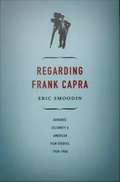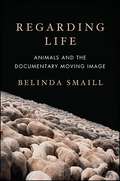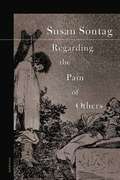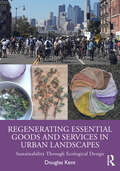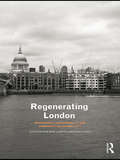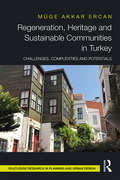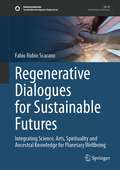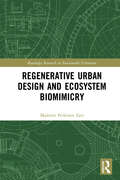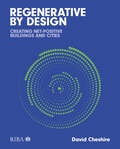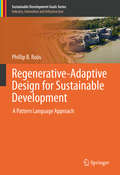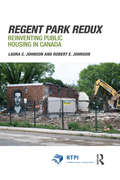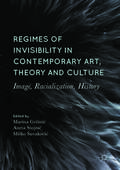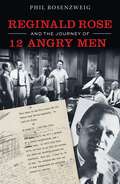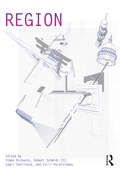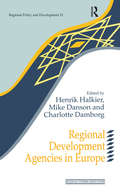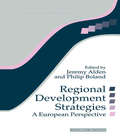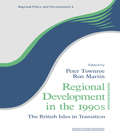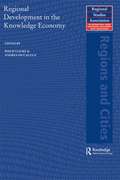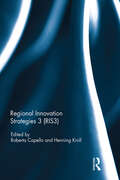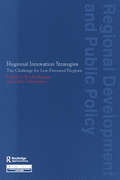- Table View
- List View
Regarding Frank Capra: Audience, Celebrity & American Film Studies, 1930-1960
by Eric SmoodinIn this innovative historical examination of the American movie audience, Eric Smoodin focuses on reactions to the films of Frank Capra. Best known for his Hollywood features--including It Happened One Night, It's a Wonderful Life, and Mr. Smith Goes to Washington--Capra also directed educational films, military films, and documentaries. Based on his analysis of the reception of a broad range of Capra's films, Smoodin considers the preferences and attitudes toward Hollywood of the people who watched movies during the "Golden Age" of studio production, from 1930 to 1960. Drawing on archival sources including fan letters, exhibitor reports, military and prison records, government and corporate documents, and trade journals, Smoodin explains how the venues where Capra's films were seen and the strategies used to promote the films affected audience response and how, in turn, audience response shaped film production. He analyzes issues of foreign censorship and government intervention in the making of The Bitter Tea of General Yen; the response of high school students to It Happened One Night; fan engagement with the overtly political discourse of Meet John Doe and Mr. Smith Goes to Washington; San Quentin prisoners' reaction to a special screening of It's a Wonderful Life; and at&t's involvement in Capra's later documentary work for the Bell Science Series. He also looks at the reception of Capra's series Why We Fight, used by the American military to train recruits and re-educate German prisoners of war. Illuminating the role of the famous director and his films in American culture, Regarding Frank Capra signals new directions for significant research on film reception and promotion.
Regarding Life: Animals and the Documentary Moving Image (SUNY series, Horizons of Cinema)
by Belinda SmaillAs indicated by the success of such films as March of the Penguins and Food, Inc., the documentary has become the preeminent format for rendering animals and nature onscreen. In Regarding Life, Belinda Smaill brings together examples from a broad array of moving image contexts, including wildlife film and television, advocacy documentary, avant-garde nonfiction, and new media to identify a new documentary terrain in which the representation of animals in the wild and in industrial settings is becoming markedly more complex and increasingly more involved with pivotal ecological debates over species loss, food production, and science.While attending to some of the most discussed documentaries of the last two decades, including Grizzly Man; Food, Inc.; Sweetgrass; Our Daily Bread; and Darwin's Nightmare, the book also draws on lesser-known film examples, and is one of the first to bring film studies understandings to new media such as YouTube. The result is a study that melds film studies and animal studies to explore how documentary films render both humans and animals, and to what political ends.
Regarding the Pain of Others
by Susan SontagHow does the spectacle of the sufferings of others (via television or newsprint) affect us? Are viewers inured--or incited--to violence by the depiction of cruelty? In Regarding the Pain of Others, Susan Sontag takes a fresh look at the representation of atrocity-from Goya's The Disasters of War to photographs of the American Civil War, lynchings of blacks in the South, and the Nazi death camps, to contemporary horrific images of Bosnia, Sierra Leone, Rwanda, Israel and Palestine, and New York City on September 11, 2001. In Regarding the Pain of Others Susan Sontag once again changes the way we think about the uses and meanings of images in our world, and offers an important reflection about how war itself is waged (and understood) in our time.
Regenerating Cities: Reviving Places and Planet (Cities and Nature)
by Maria Elena Zingoni de BaroThis book sets out the discussion on how cities can contribute solutions to some of the challenges the urbanised world is facing, such as the pressure of growing populations, mitigation of effects of, and adaptation to globally changing environmental, climate and public health conditions. Presenting a detailed explanation of the causes behind the current state of modern cities, the book advocates for a paradigm shift to improve the quality of life of ever-increasing urban inhabitants whilst nourishing the natural systems that sustain human and non-human life in the planet. Recognising the precious role that nature plays in the functioning of cities, it delves into the study of biophilic design and regenerative development. The book argues that these social-ecological design approaches can act as catalysts to develop conditions in urban settings that are beneficial for natural and human systems to thrive and flourish, both in ecosystem services and social-cultural systems. This is particularly relevant for the design of new quality precincts or the regeneration of degraded urban spaces to promote health, wellbeing and urban resilience. A framework is proposed to guide the process of thinking about, designing and building healthier, more liveable and resilient urban environments that raise the quality of life in cities. The method can be used by researchers, practitioners -urban designers, urban planners, architects and landscape architects- interested in developing their work within a social-ecological perspective. It can also be used by local governments and agencies to underpin policy making, and by educational institutions to prepare graduates with necessary skills to respond to current and future built environment challenges.
Regenerating Essential Goods and Services in Urban Landscapes: Sustainability Through Ecological Design
by Douglas KentHow do we provide for and nurture millions of people without destroying the planet in the process? Author Doug Kent, an environmental specialist, believes a vital element in the solution is recognizing that urban landscapes are an essential partner in everyone’s wellbeing. He argues that urban landscapes can and must work harder.Urban landscapes can provide part of our energy needs, help cool our buildings and public spaces, help us make the most of our precious water. They can also help combat air pollution and reduce the likelihood of allergies and asthma. They can provide landscape materials and even contribute to our timber supply. Doug also advocates turning landscapes into a food source, and/or a perfumery, pharmacy, soap shop, or craft store.Doug has over 12 years of research in this book. He has spent years doing literature reviews, and many more years concocting, consuming, crafting, distilling, propagating, retting, sawing, sowing, and weaving its many recommendations. He has also travelled the length and width of California many times to interview the people and businesses already doing this incredible work.Regenerating Essential Goods and Services is not a manifesto. It is a user’s manual. You are the creative and energetic force that will ultimately drive sustainability and regeneration. Let’s go.
Regenerating London: Governance, Sustainability and Community in a Global City
by Rob Imrie Loretta Lees Mike RacoRegenerating London explores latest thinking on urban regeneration in one of the fastest changing world cities. Engaging with social, economic, and political structures of cities, it highlights paradoxes and contradictions in urban policy and offers an evaluation of the contemporary forms of urban redevelopment.
Regeneration, Heritage and Sustainable Communities in Turkey: Challenges, Complexities and Potentials
by Muge Akkar ErcanOver the last three decades, historic housing areas have become one of the major concerns in urban regeneration, housing renovation and conservation projects. Since the late 1990s, the notion of community, sustainability and sustainable community have become rising issues in the urban regeneration debate. Regeneration, Heritage and Sustainable Communities in Turkey contributes to this debate by integrating the interplay between regeneration, community needs and sustainability in the context of Istanbul. Together with the relational, multi-scalar and contingency planning approaches, these vital agents of regeneration provide new possibilities and creative opportunities to successfully deal with the uncertainties and complexities in evolving regeneration spaces. The interdisciplinary text reasons that finding the balance between the needs, aspirations and concerns of local communities and the conservation of the built environments will lead to more equitable and sustainable solutions to the problems faced in Istanbul’s historic quarters.
Regenerative Development and Design: A Framework for Evolving Sustainability
by Regenesis GroupThe evolution of sustainability, with a practical framework for integration Regenerative Development and Design takes sustainability to the next level, and provides a framework for incorporating regenerative design principles into your current process. The Regenesis Group is a coalition of experienced design, land-use, planning, business, and development professionals who represent the forefront of the movement; in this book, they explain what regenerative development is, how and why it works, and how you can incorporate the fundamental principles into your practice. A clear, focused framework shows you how to merge regenerative concepts with your existing work, backed by numerous examples that guide practical application while illustrating regenerative design and development in action. As the most comprehensive and systemic approach to regenerative development, this book is a must-have resource for architects, planners, and designers seeking the next step in sustainability. Regenerative design and development positions humans as co-creative and mutually-evolving participants in an ecosystem--not just a built environment. This book describes how to bring that focus to your design from the earliest stages. Understand the fundamentals of regenerative design and development Learn how regenerative development contributes to sustainability Integrate regenerative development concepts into practice Examine sample designs that embody the regenerative concept To create a design with true sustainability, considerations must extend far beyond siting, materials, and efficiency. Designers must look at the place, it's inhabitants, and the purpose--the whole living ecosystem--and proceed with their work from that more humbling perspective. The finished product should itself be an ecosystem and sustainable economy, which is the root of the regenerative development approach. Sustainability has evolved, and the designer's responsibility has increased in kind. Regenerative Development and Design provides an authoritative resource for those ready to take the next step forward.
Regenerative Dialogues for Sustainable Futures: Integrating Science, Arts, Spirituality and Ancestral Knowledge for Planetary Wellbeing (Sustainable Development Goals Series)
by Fabio ScaranoThis book is about sustainability in its broadest sense. It argues that the ongoing science-policy dialogue on sustainable development (as framed by the United Nations’ Sustainable Development Goals) is insufficient to drive the planet to desired sustainable futures. This conversation, followed by transformative action, must be inclusive of other forms of interpretation of reality (arts, spirituality, and ancestral knowledge) and non-modern cosmovisions. This is more a book about dialogues than about the common dualism problem/solution, and such dialogues are approached as an essential trigger of regeneration. The book takes the reader from a historical perspective of the human-nature relationship through to a discussion on sustainable futures as utopias. The optimism conveyed by the book is justified by a plethora of global examples of such regenerative dialogues.
Regenerative Fashion
by Safia MinneyAs our climate, ecological and social crises converge, urgent action is needed to maximize our chances of survival. A new commercial approach is possible but it requires a systemic shift, with companies learning to operate as part of a wider 'ecosystem', allowing fashion to restore what it has taken.Regenerative Fashion presents a roadmap for new ways of doing fashion. To keep our planet safe, we must cut production and end our dependency on fossil fuels. We must also create dignified livelihoods for the millions of people working in the industry. By using natural resources, paying factory workers and farmers a living wage and scaling up craft production, we can not only rebuild soils, ecosystems and biodiversity, but also support decarbonization, regenerate communities and ensure a just transition for all.Part guide and part manifesto, this book shares stories of our interconnectedness with the natural world and each other, divided into sections on Nature & Materials; People, Livelihoods & Crafts; and New Economy & Leadership. Fully illustrated throughout, it features interviews from best-practice designers and businesses around the world, as well as thought pieces from leading campaigners within the industry.
Regenerative Fashion
by Safia MinneyAs our climate, ecological and social crises converge, urgent action is needed to maximize our chances of survival. A new commercial approach is possible but it requires a systemic shift, with companies learning to operate as part of a wider 'ecosystem', allowing fashion to restore what it has taken.Regenerative Fashion presents a roadmap for new ways of doing fashion. To keep our planet safe, we must cut production and end our dependency on fossil fuels. We must also create dignified livelihoods for the millions of people working in the industry. By using natural resources, paying factory workers and farmers a living wage and scaling up craft production, we can not only rebuild soils, ecosystems and biodiversity, but also support decarbonization, regenerate communities and ensure a just transition for all.Part guide and part manifesto, this book shares stories of our interconnectedness with the natural world and each other, divided into sections on Nature & Materials; People, Livelihoods & Crafts; and New Economy & Leadership. Fully illustrated throughout, it features interviews from best-practice designers and businesses around the world, as well as thought pieces from leading campaigners within the industry.
Regenerative Urban Design and Ecosystem Biomimicry (Routledge Research in Sustainable Urbanism)
by Maibritt Pedersen ZariIt is clear that the climate is changing and ecosystems are becoming severely degraded. Humans must mitigate the causes of, and adapt to, climate change and the loss of biodiversity, as the impacts of these changes become more apparent and demand urgent responses. These pressures, combined with rapid global urbanisation and population growth mean that new ways of designing, retrofitting and living in cities are critically needed. Incorporating an understanding of how the living world works and what ecosystems do into architectural and urban design is a step towards the creation and evolution of cities that are radically more sustainable and potentially regenerative. Can cities produce their own food, energy, and water? Can they be designed to regulate climate, provide habitat, cycle nutrients, and purify water, air and soil? This book examines and defines the field of biomimicry for sustainable built environment design and goes on to translate ecological knowledge into practical methodologies for architectural and urban design that can proactively respond to climate change and biodiversity loss. These methods are tested and exemplified through a series of case studies of existing cities in a variety of climates. Regenerative Urban Design and Ecosystem Biomimicry will be of great interest to students, professionals and researchers of architecture, urban design, ecology, and environmental studies, as well as those interested in the interdisciplinary study of sustainability, ecology and urbanism.
Regenerative by Design: Creating living buildings and cities
by David CheshireHow do we design cities and buildings that metabolise, use living materials and are net positive - that give back more to the planet than they take?Our cities and buildings are a drain on the planet, requiring huge amounts of resources and tracts of land to support their needs, and destroying biodiversity in the process. The idea of living, regenerative buildings is gaining ground - buildings that give back more than they take, providing habitats, ecosystems services (e.g. clean water, clean air), locally-grown food, and putting humans back in touch with the natural world.The climate and biodiversity crisis has driven organisations to set ambitious net zero carbon and ESG targets: however, many are struggling to see how to achieve them and often doing the same thing, but expecting a different result.This book sets out the regenerative building agenda and design principles, showing how buildings, towns and cities could start to have a positive impact on our planet, providing ecosystems services and living within the means afforded by the site.
Regenerative-Adaptive Design for Sustainable Development: A Pattern Language Approach (Sustainable Development Goals Series)
by Phillip B. RoösIn this book, the author tests a regenerative-adaptive pattern language theory towards investigating the possibilities of a holistic, integrated design and planning method for sustainable development that incorporates the principles of regenerative design, as well as an adaptive pattern language that re-establishes our wholeness with nature, and considers the vulnerabilities of a changing landscape. The book examines an integral approach to contemporary theories of planning and design that explores the human-nature relationship patterns in social and spatial interconnections, between people and their natural environments. The interconnectedness of human and natural systems is used to scaffold possible solutions to address key environmental and sustainability issues that specifically address the need for patterns of behaviour that acknowledge the duality of ‘man and nature’. In 12 chapters, the book presents a holistic, regenerative-adaptive pattern language that encapsulates how communities can better appreciate landscape change under future climate effects, and acknowledges the importance to adapt to patterns of change of place and the environment and therefore inform the communities’ responses for sustainable development. The application of the regenerative-adaptive pattern language was tested along the Great Ocean Road region of the Victorian coast in Australia. The concluding chapters argues that for human settlements and cities to be resilient and sustainable, we must understand the interconnected patterns of human-built environments and natural systems, and how we function in a social-spatial dimension with these. The book is intended for practitioners and academic scholars with interest in sustainable development, regenerative design, pattern languages, biophilia, settlement planning, and climate change adaptation.
Regent Park Redux: Reinventing Public Housing in Canada (RTPI Library Series)
by Laura Johnson Robert JohnsonRegent Park Redux evaluates one of the biggest experiments in public housing redevelopment from the tenant perspective. Built in the 1940s, Toronto’s Regent Park has experienced common large-scale public housing problems. Instead of simply tearing down old buildings and scattering inhabitants, the city’s housing authority came up with a plan for radical transformation. In partnership with a private developer, the Toronto Community Housing Corporation organized a twenty-year, billion-dollar makeover. The reconstituted neighbourhood, one of the most diverse in the world, will offer a new mix of amenities and social services intended to "reknit the urban fabric." Regent Park Redux, based on a ten-year study of 52 households as they moved through stages of displacement and resettlement, examines the dreams and hopes residents have for their community and their future. Urban planners and designers across the world, in cities facing some of the same challenges as Toronto, will want to pay attention to this story.
Regimes of Invisibility in Contemporary Art, Theory and Culture
by Marina Gržinić Aneta Stojnić Miško ŠuvakovićThis book places a focus on the regimes of in/visibility and representation in Europe and offers an innovative perspective on the topic of global capitalism in relation to questions of race, class, gender and migration, as well as historicization of biopolitics and (de)coloniality. The aim of this volume is to revisit theories of art, new media technology, and aesthetics under the weight of political processes of discrimination, racism, anti-Semitism and new forms of coloniality in order to propose a new dispositive of the ontology and epistemology of the image, of life and capitalism as well as labor and modes of life. This book is firmly embedded in the present moment, when due to rapid and major changes on all levels of political and social reality the need for rearticulation in theoretical, artistic and political practices and rethinking of historical narratives becomes almost tangible.
Reginald Rose and the Journey of 12 Angry Men
by Phil RosenzweigFinalist, 2021 Wall Award (Formerly the Theatre Library Association Award)The untold story behind one of America’s greatest dramasIn early 1957, a low-budget black-and-white movie opened across the United States. Consisting of little more than a dozen men arguing in a dingy room, it was a failure at the box office and soon faded from view.Today, 12 Angry Men is acclaimed as a movie classic, revered by the critics, beloved by the public, and widely performed as a stage play, touching audiences around the world. It is also a favorite of the legal profession for its portrayal of ordinary citizens reaching a just verdict and widely taught for its depiction of group dynamics and human relations. Few twentieth-century American dramatic works have had the acclaim and impact of 12 Angry Men.Reginald Rose and the Journey of “12 Angry Men” tells two stories: the life of a great writer and the journey of his most famous work, one that ultimately outshined its author. More than any writer in the Golden Age of Television, Reginald Rose took up vital social issues of the day—from racial prejudice to juvenile delinquency to civil liberties—and made them accessible to a wide audience. His 1960s series, The Defenders, was the finest drama of its age and set the standard for legal dramas. This book brings Reginald Rose’s long and successful career, its origins and accomplishments, into view at long last.By placing 12 Angry Men in its historical and social context—the rise of television, the blacklist, and the struggle for civil rights—author Phil Rosenzweig traces the story of this brilliant courtroom drama, beginning with the chance experience that inspired Rose, to its performance on CBS’s Westinghouse Studio One in 1954, to the feature film with Henry Fonda. The book describes Sidney Lumet’s casting, the sudden death of one actor, and the contribution of cinematographer Boris Kaufman. It explores the various drafts of the drama, with characters modified and scenes added and deleted, with Rose settling on the shattering climax only days before filming began.Drawing on extensive research and brimming with insight, this book casts new light on one of America’s great dramas—and about its author, a man of immense talent and courage.Author royalties will be donated equally to the Feerick Center for Social Justice at Fordham Law School and the Justice John Paul Stevens Jury Center at Chicago-Kent College of Law.
Region (Critiques Ser.)
by Simon Richards Robert Schmidt III Cagri Sanliturk Falli PalaiologouThis book explores how the concept of ‘region’ has evolved over time and shaped architectural culture and practice. It questions what the words ‘region’ and ‘regional’ mean for architecture, cities and landscapes past and present, and speculates on the forms they might take in the future. Region is explored in many thematic guises: as a real geographical site of evolving socio-economic activity; as a mythical locus of enduring value; as a gatekeeper of indigenous crafts and vernacular techniques; as a site of architectural and artistic imagination; as a repository of contested, conflicted and mobile identities. The contributing chapters take these themes from the theoretical and literary page through to architectural and urban practice, and from the scale of the domestic hearth through to the ocean archipelago and international law, enriching the long-standing trope of viewing architectural regionalism purely as a matter of style. Curated into four key thematic areas – Theorised Regions, Contested Regions, Heritage Regions and Future Regions – the book incorporates the values, concerns and approaches of a truly diverse international community of scholars, curators and practitioners, as well as the design work of international students tasked to explore what region means to them.
Regional Development Agencies in Europe (Regions and Cities #Vol. 21)
by Henrik Halkier Mike Danson Charlotte DamborgIn the past decade Europe has seen much change, and at the same time the importance of the regional perspectives has significantly increased. Regional Development Agencies in Europe brings together experiences of Regional and Development Agencies throughout Europe to provide material for the first major comparative study of bottom-up regional policy across the continent. Using an analytical framework developed by editors, the contributors evaluate the long term potential and limitations of the RDAs in terms of promoting regional and economic development. Institutional and other preconditions for successful regional polices are identified, and combined with a broad analytical and geographical coverage that includes Eastern Europe, a clearer picture of the relevance of the RDAs emerges.
Regional Development Strategies: A European Perspective (Regions and Cities #Vol. 15)
by Jeremy Alden Philip BolandRegional development strategies have become the focus of attention in many countries in the 1990s. This textbook provides a conceptual, theoretical and empirical analysis of regional development strategies within a European context It examines the various regional development strategies which are currently being pursued within the regions of Europe - defined in its loosest term to include East and West. The book describes how many different European regions are attempting to reduce regional disparities by engaging themselves in coherent and focused regional development strategies, and there is also private sector approach to regional economic development. There are many case studies from Europe and from other parts of the world, including Japan, thereby providing lessons that different countries and regions can learn form each other.
Regional Development in the 1990s: The British Isles in Transition (Regions and Cities #No. 4)
by Ron Martin Peter TownroeThis book documents the changing nature and challenge of regional development in Britain and Ireland in the final decade of this century. In the first half of this book, region-by-region profiles review the experience of the eighties and reflect on the present climate, assessing problems and opportunities. The second half provides 25 commentaries on changes influencing the development of regions from questions of industry, technology and employment to the impact of national policy and 1992, and the prospects and capacity for regional policy and development.
Regional Development in the Knowledge Economy (Regions and Cities)
by Philip Cooke Andrea PiccalugaInternational contributors provide the first examination of the growing subject of regional knowledge-economy development. Illustrated by data and 'stylized' accounts, the international contributors chart the evolution of knowledge economies, questioning the way in which they work and criticize accepted theories and inform how places can cope in the knowledge economy. Based in concept on Cooke's Knowledge Economies (Routledge, 2002), Regional Development in the Knowledge Economy is a well-grounded work exploring this increasingly important theme with relevance to innovation systems and related economic development literature.
Regional Equity (Community Development – Current Issues Series)
by Victor RubinRegional equity as a field of scholarship, as an arena of policy change, and as a social movement has grown, diversified, and matured in important ways over the past decade. The fruits of that growth and development can be seen in recent federal and state policies, in the practices of many regional planning organizations, and in the agendas and approaches of countless community-based organizations and issue advocacy groups.As the field has expanded, a growing number of researchers have been tracking these phenomena: explaining how and why concepts of metropolitan development are being reframed; documenting the efforts to shape policies and diversify leadership; assessing where and how equity and social justice concerns have been brought into regional planning for transportation, land use, housing, public finances, environmental quality, smart growth, sustainable development, public health and other issue areas. This volume brings together analyses and commentary by some of the leading scholarly observers these timely developments.This book was published as a special issue of Community Development.
Regional Innovation Strategies 3 (RIS3)
by Roberta Capello Henning KrollWith regions and nations having formally fulfilled the ex ante conditionality, this book provides a first overall review of RIS3 policy processes, aiming to assess the consistency of the concept of smart specialization from an applied, policy-oriented perspective. Moving from the theory of design to the practice of implementation, the reflections and case studies in this volume reveal strengths and weaknesses in the way concrete strategies have been conceived and implemented, enabling reflections on the future of the concept in a more general sense. In many cases, smart specialization strategies turn out to be new variants of regional development policies, embracing the importance of a place-based approach. However, the approach’s potential to add distinctive value will stem from its capacity to turn innovation and knowledge into tools for local development by harnessing them for wider territorial development goals. By helping regions to identify and leverage untapped resources through new processes, smart specialization-based policies may help to reconcile cohesion and competitiveness objective. Consequently, new approaches appear most promising where institutional, administrative and political conditions allow the setup of genuinely new processes and where their focus is on territorial assets in a comprehensive manner rather than mere industrial renewal. This book was originally published as a special issue of European Planning Studies.
Regional Innovation Strategies: The Challenge for Less-Favoured Regions (Regions and Cities #Vol. 24)
by Kevin Morgan Claire NauwelaersRegional Innovation Strategiesoffers the first comprehensive analysis of the new wave of innovation-oriented regional policies. It draws conclusions from the European Regional Technology Plans and Regional Innovation Strategies, both in old industrialised areas and in regions where development is slow, and compares this with US and Canadian experiences. Anticipating the enlargement of the EU, Regional Innovation Strategies also assesses the growing interest in the subject within policy, academic and practitioner circles in Central and Eastern European countries. This book aims to provide information on the new regional innovation polices and gives the first assessment of this promising pool of regional experiences.
